#Bhārata
Explore tagged Tumblr posts
Text
from mikjikj-mnikuk/turtle island to inuit nunangat to kanata to kalaallit nunaat to anahuac to abya yala to alkebulan to the levant to moananuiākea to sápmi to éire to bhārata to zhōngguó to nihon to aynu mosir to siberia to niugini to nusantara to bandaiyan to aotearoa, from coast to coast to coast to coast, from sea to sea to sea to sea, none of us are free until all of us — men, women, enben, children, queer people, disabled & neurodivergent people, elders, animals and the land and the sea and the sky — are free!!!!
#arcana.txt#turtle island = north america aka canada america & mexico (& the carribean & central america & greenland depending on who you ask)#inuit nunangat = the arctic aka inuit territory#anahuac = the traditional name for mexico#abya yala = south america (& the carribean & central america depending on who you ask)#alkebulan = the indigenous name for africa#levant = the place where israel & palestine are but also includes cyprus jordan lebanon & syria#moananuiākea = the hawaiian word for the pacific ocean & all the pacific islands#sápmi = the traditional land of the sámi in the northern parts of scandinavia & sweden norway finland & russia#bandaiyan = the indigenous word for australia / aotearoa = the māori word for new zealand#& the reason why i& included animals & the land sea & sky was bc that's central to indigenous activism just as much as it relates to humans#ya can't just free the humans ya gotta free the lands seas & skies too!!#btw mikjikj-mnikuk means turtle island in mi'kmawi'simk i& found it fitting to use the oldest language that yt europeans heard when arrivin#as the mi'kmaq were literally the first indigenous peoples that yt settlers spoke to & saw in 'canada' aka kanata which is the actual word+#which it originated from which came from a huron-iroquois word!!#+ zhōngguó is the chinese word for china ! i& included it bc the uighurs & tibetans & other idigenous peoples are still struggling there!!#+ nihon is the word for japan & i& added it bc we can't forget the ainu & okinawans !!#kalaallit nunaat = greenland & éire = ireland in gaeilge#niugini = new guinea in tok pisin / nusantara = indonesia & the archipelago from old javanese bc they have a lot of indigenous peoples#bhārata = india — i& added it bc there's a LOT of indigenous peoples there & the caste system often has them at the bottom#aynu mosir = ainu homelands !!#siberia also has MANY indigenous peoples living in literally the coldest parts of the world & they're going thru a lot rn#nobody's free until all of us are free!!!!#protect indigenous peoples everywhere!!!! protect each other!!!!#protect the lands seas & skies & also keep them centered in your activism while making sure human rights are valued!!#land back#activism.#psa.#** post; okay to reblog.
29 notes
·
View notes
Text
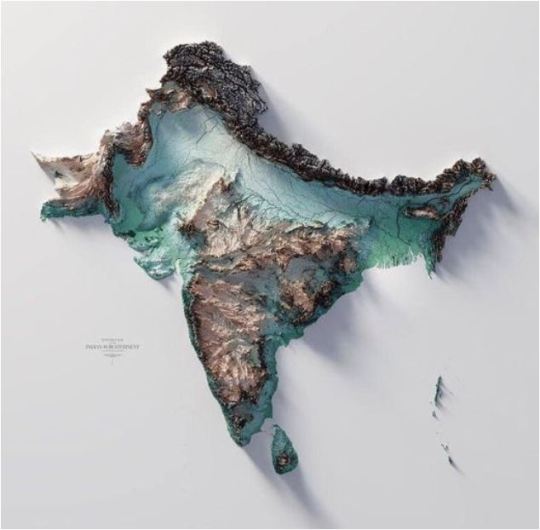
Bharat ou Bharath Pas India (Inde ), Inde ou India sera Bharat bientôt (L’Inde reprend son ancien nom et efface son nom de britannique)
Bhārata
भारत (Bhārata) est le nom du pays en sanskrit. Dans les Puranas, ce terme apparaît sous la forme Bhārata varṣam (« le pays de Bharata ») pour désigner l'Inde par opposition aux autres varṣas ou pays et il viendrait du nom du roi Bharata Chakravartin. Dans la littérature en sanskrit, le terme Bhārata désigne l'ensemble du sous-continent.
Inde
Le terme « Inde » dérive initialement de Sindhu, nom en sanskrit du fleuve Indus. Ce mot peut aussi être traduit par « mer » ou « rivière », « fleuve »
Le nom a été utilisé en persan ancien sous la forme Hinduš, en grec Ἰνδία / Indía puis en latin India, pour désigner la région située à l'est de l'Indus. Hérodote (ve siècle av. J.-C.) parlait dans l'Enquête (livre III, 95) de τῶν Ἰνδός / tôn Indós, « les Indiens » Il mentionne aussi ἡ Ἰνδική χώρη / hē Indikē chōrē, « le pays indien »
7 notes
·
View notes
Text
What a Difference a Dey Makes.

Helen Lisa O’Day had long suspected her husband Robert of dressing up in her clothes when she was away from home going to her job as a state wide substitute teacher, other than the pitting out of them sometimes she didn’t mind. She supposed it made him happy that was fine with her. She just wished he felt comfortable enough with himself to tell her.
Helen, however, figured that after she had gone to the remarkable shop owned by three women from India who sold clothing that somehow turned their western clients into Indian women.
So after taking their month-long `give it a try’ challenge Helen Lisa O’Day, a substitute teacher born in Salem, Massachusetts found herself changed into someone who could now only think of herself as Heera Leesha O’day of Salem, Tamil Nadu State, India, that it was the end of Robert’s cross-dressing, at least with her clothes.
Remarkably excepting of her fantastic transformation (helped by an embroidered pillow cover the sisters sold that "helps those not changed to accept those who have. ") Robert was, however, continuously going on about “how do you deal with all that...wrapping?” he would say, “you just have to practice,” Heera would reply.
Then Heera Leesha found a new occupation working for You Are What You Ware as a Precious metal jewelry designer making the type of gold and silver jewelry the newly minted Bhārata women coming out of the five shops now owned by the Sharma sisters seemed to all love.
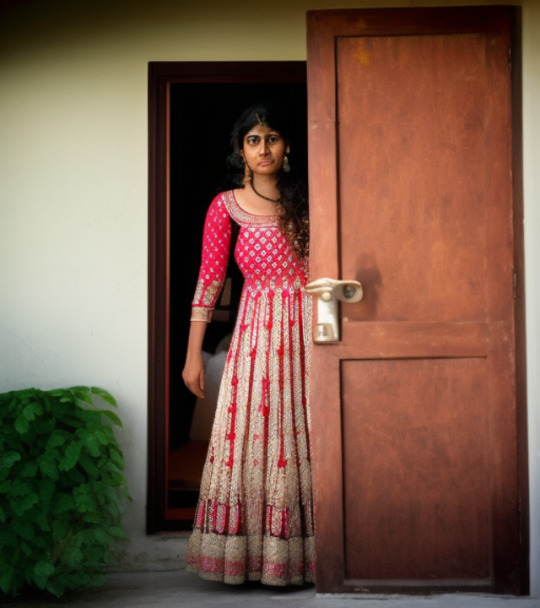
Her new job took her away from home even more now, just as it had for the last week with her returning late on a Friday; she did not think she would have to worry about any of her new clothing being pitted out due to Roberts's intimidation of “all that wrapping and draping.”
“Hello dear, I’m back,” said Heera, sure to use English as Robert spoke not a word of the Tamil she now spoke fluently, as well as her old English, though now flavored with a pronounced Tamil accent.
“Vaṇakkam” (hello) “Nāṉ oppukkoḷḷa vēṇṭum” (I have to confess) said a high-pitched woman’s voice in Tamil. That was when a petite young woman wearing one of her dresses presented herself. A woman whose face still bore a semblance to her husband Robert., if that is, he had been a woman born much further East than his original New Jersey.
“I can guess what that confession is,” said Heera thinking that at least now Robert would not be pitting out her new dresses; her new clothing had shrunk him to fit them.
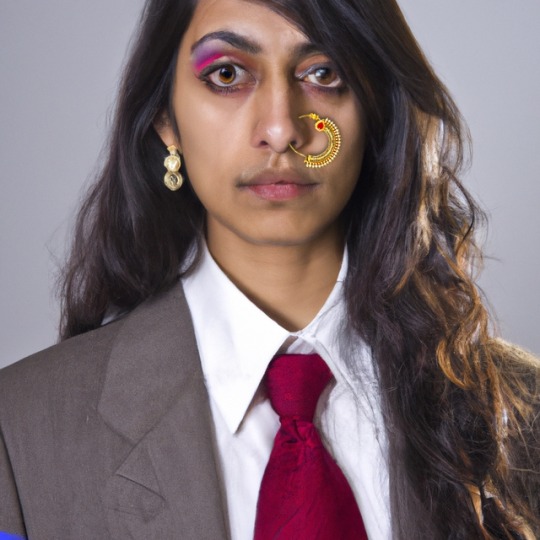
A month later, Robert, on he and Heera finding that no, there was no going back, was set up as the new Rohana Dey. Heera even gifted the new woman with a striking gold and ruby nath nose ring to say well, here we are now.
The expectation was that Rohana would go to You Are What You Wear to be fully outfitted for her new self.
Instead, she surprised Heera by going to her old tailor she had used when she had been Robert.
There she got five new suits made to fit her new form. “I am a computer programmer,” she said, “and this is how I dress when I’m working; the other things are just for fun.”
Rohana Dey, however, wore her nath when suited up. “it works for me,” she said.
12 notes
·
View notes
Photo

पश्यादित्यान्वसून्रुद्रानश्र्विनौ मरुतस्तथा | बहून्यदृष्टपूर्वाणि पश्याश्र्चर्याणि भारत || ६ || paśyādityān vasūn rudrān aśvinau marutas tathā bahūny adṛṣṭa-pūrvāṇi paśyāścaryāṇi bhārata O best of the Bhāratas, see here the different manifestations of Ādityas, Rudras, and all the demigods. Behold the many things which no one has ever seen or heard before. Even though Arjuna was a personal friend of Kṛṣṇa and the most advanced of learned men, it was still not possible for him to know everything about Kṛṣṇa. Here it is stated that humans have neither heard nor known of all these forms and manifestations. Now Kṛṣṇa reveals these wonderful forms. https://gloriousgita.com/verse/en/11/6 https://bhagavad-gita.org/Gita/verse-11-06.html https://vedabase.io/en/library/bg/11/6/ https://bookchanges.com/wp-content/uploads/2009/09/Bg-Chapter-11-diff.htm https://youtube.com/c/HearSrilaPrabhupada https://www.bhagavad-gita.us/famous-reflections-on-the-bhagavad-gita/ #bhagavatam #srimadbhagavatam #vishnu #vishnupuran #harekrishna #harekrsna #harekrishna #harekrisna #prabhupada #bhagavadgita #bhagavadgitaasitis #bhagavadgītā #srilaprabhupada #srilaprabhupad #srilaprabhupadaquotes #asitis #india #indian #wayoflife #religion #goals #goaloflife #spiritual #bhakti #bhaktiyoga #chant #prasadam #picoftheday #photo #beautiful #usa https://sites.google.com/view/sanatan-dharma https://m.facebook.com/HDG.A.C.Bhaktivedanta.Svami.Srila.Prabhupada.Uvaca/ https://www.instagram.com/p/Cqrm1Jqovqd/?igshid=NGJjMDIxMWI=
#bhagavatam#srimadbhagavatam#vishnu#vishnupuran#harekrishna#harekrsna#harekrisna#prabhupada#bhagavadgita#bhagavadgitaasitis#bhagavadgītā#srilaprabhupada#srilaprabhupad#srilaprabhupadaquotes#asitis#india#indian#wayoflife#religion#goals#goaloflife#spiritual#bhakti#bhaktiyoga#chant#prasadam#picoftheday#photo#beautiful#usa
4 notes
·
View notes
Text
“mātrā-sparśās tu kaunteya
śītoṣṇa-sukha-duḥkha-dāḥ
āgamāpāyino 'nityās
tāṁs titikṣasva bhārata”
“O son of Kuntī, the nonpermanent appearance of happiness and distress, and their disappearance in due course, are like the appearance and disappearance of winter and summer seasons. They arise from sense perception, O scion of Bharata, and one must learn to tolerate them without being disturbed.”
Excerpt From
Bhagavad Gita Ch. 2 Verse 14
7 notes
·
View notes
Photo

श्रीमद् भगवद्गीता यथारूप 2.30 देही नित्यमवध्योऽयं देहे सर्वस्य भारत । तस्मात्सर्वाणि भूतानि न त्वं शोचितुमर्हसि ॥ २.३० ॥ TRANSLATION हे भारतवंशी! शरीर में रहने वाले (देही) का कभी भी वध नहीं किया जा सकता। अतः तुम्हें किसी भी जीव के लिए शोक करने की आवश्यकता नहीं है । PURPORT अब भगवान् अविकारी आत्मा विषयक अपना उपदेश समाप्त कर रहे हैं। अमर आत्मा का अनेक प्रकार से वर्णन करते हुए भगवान् कृष्ण ने आत्मा को अमर तथा शरीर को नाशवान सिद्ध किया है। अतः क्षत्रिय होने के नाते अर्जुन को इस भय से कि युद्ध में उसके पितामह भीष्म तथा गुरु द्रोण मर जायेंगे अपने कर्तव्य से विमुख नहीं होना चाहिए। कृष्ण को प्रमाण मानकर भौतिक देह से भिन्न आत्मा का पृथक् अस्तित्व स्वीकार करना होगा, यह नहीं कि आत्मा जैसी कोई वस्तु नहीं है या कि जीवन के लक्षण रसायनों की अन्तःक्रिया के फलस्वरूप एक विशेष अवस्था में प्रकट होते हैं। यद्यपि आत्मा अमर है, किन्तु इससे हिंसा को प्रोत्साहित नहीं किया जाता। फिर भी युद्ध के समय हिंसा का निषेध नहीं किया जाता क्योंकि तब इसकी आवश्यकता रहती है। ऐसी आवश्यकता ��ो भगवान् की आज्ञा के आधार पर उचित ठहराया जा सकता है, स्वेच्छा से नहीं । ----- Srimad Bhagavad Gita As It Is 2.30 dehī nityam avadhyo ’yaṁ dehe sarvasya bhārata tasmāt sarvāṇi bhūtāni na tvaṁ śocitum arhasi TRANSLATION O descendant of Bharata, he who dwells in the body can never be slain. Therefore you need not grieve for any living being. PURPORT The Lord now concludes the chapter of instruction on the immutable spirit soul. In describing the immortal soul in various ways, Lord Kṛṣṇa establishes that the soul is immortal and the body is temporary. Therefore Arjuna as a kṣatriya should not abandon his duty out of fear that his grandfather and teacher – Bhīṣma and Droṇa – will die in the battle. On the authority of Śrī Kṛṣṇa, one has to believe that there is a soul different from the material body, not that there is no such thing as soul, or that living symptoms develop at a certain stage of material maturity resulting from the interaction of chemicals. Though the soul is immortal, violence is not encouraged, but at the time of war it is not discouraged when there is actual need for it. That need must be justified in terms of the sanction of the Lord, and not capriciously. -----
3 notes
·
View notes
Text
SAHASRANAMA OF VISHNU: 539 of 1,000
GOVINDAḤ {गोविन्द:} When Yudhiṣṭhira called him Govinda and asked him to occupy the seat of honor at the Rājasūya Yājña, it was an acknowledgement of who was the protector of all at that time in the land of Bhārata. Not just for “that time” but for all eternity – he alone is the protector at all times. If there was one lesson that Bhīṣma had learnt and hoped the future generations of Bhāratiyas…

View On WordPress
0 notes
Text
శ్రీమద్భగవద్గీత - 574: 16వ అధ్., శ్లో 03 / Bhagavad-Gita - 574: Chap. 16, Ver. 03

🌹. శ్రీమద్భగవద్గీత - 574 / Bhagavad-Gita - 574 🌹 ✍️. శ్రీ ప్రభుపాద, 📚. ప్రసాద్ భరద్వాజ 🌴. 16వ అధ్యాయము - దైవాసుర స్వభావములు - 3 🌴 3. తేజ: క్షమా ధృతి: శౌచమద్రోహో నాతిమానితా | భవన్తి సమ్పదం దైవీమభిజాతస్య భరత || 🌷. తాత్పర్యం : తేజము, క్షమ, ధైర్యము, శుచిత్వము, అసూయరాహిత్యము, గౌరవవాంఛ లేకుండుట అను దివ్యగుణములు దైవీస్వభావము కలిగిన దివ్యుల యందుండును.
🌷. భాష్యము :
🌹 🌹 🌹 🌹 🌹
🌹 Bhagavad-Gita as It is - 574 🌹 ✍️ Sri Prabhupada, 📚 Prasad Bharadwaj 🌴 Chapter 16 - The Divine and Demoniac Natures - 3 🌴 3. tejaḥ kṣamā dhṛtiḥ śaucam adroho nāti-mānitā bhavanti sampadaṁ daivīm abhijātasya bhārata
🌷 Translation : vigor; forgiveness; fortitude; cleanliness; and freedom from envy and from the passion for honor – these transcendental qualities, O son of Bharata, belong to godly men endowed with divine nature.
🌹 Purport :
🌹 🌹 🌹 🌹 🌹
0 notes
Text
Unmanifest Before And After
“All created beings are unmanifest in their beginning, manifest in their interim state, and unmanifest again when they are annihilated. So what need is there for lamentation?” (Lord Krishna, Bhagavad-gita, 2.28) Download this episode (right click and save) अव्यक्तादीनि भूतानि व्यक्तमध्यानि भारत अव्यक्तनिधनान्येव तत्र का परिदेवना avyaktādīni bhūtāni vyakta-madhyāni bhārata avyakta-nidhanāny eva…

View On WordPress
0 notes
Text

The Roads of the Foolish and the Wise

Just as there are four types of miscreants who never surrender to Kṛṣṇa, there are four types of fortunate men who worship Him, and they are categorized in the next verse:
“O best among the Bhāratas [Arjuna], four kinds of pious men render devotional service unto Me – the distressed, the desirer of wealth.
1 note
·
View note
Text
mātrā-sparśās tu kaunteya
śītosna-sukha-duhkha-dāh
āgamāpāyino ’nityās
tāms titiksasva bhārata
„O son of Kuntī, the nonpermanent appearance of heat and cold, happiness and distress, and their disappearance in due course, are like the appearance and disappearance of winter and summer seasons. They arise from sense perception, O scion of Bharata, and one must learn to tolerate them without being disturbed.“
(Bg. 2.14)
1 note
·
View note
Text
🌹 02, MAY 2024 THURSDAY ALL MESSAGES గురువారం, బృహస్పతి వాసర సందేశాలు🌹
🍀🌹 02, MAY 2024 THURSDAY ALL MESSAGES గురువారం, బృహస్పతి వాసర సందేశాలు🌹🍀 1) 🌹. శ్రీమద్భగవద్గీత - 527 / Bhagavad-Gita - 527 🌹 🌴. 13వ అధ్యాయము - క్షేత్ర క్షేత్రజ్ఞ విభాగ యోగం - ప్రకృతి, పురుషుడు, చైతన్యము - 38 / Chapter 13 - Kshetra Kshtrajna Vibhaga Yoga - Nature, the Enjoyer and Consciousness - 38 🌴 2) 🌹. శ్రీ శివ మహా పురాణము - 881 / Sri Siva Maha Purana - 881 🌹 🌻. శంఖచూడుని సైన్యమును వధించుట - 1 / The annihilation of the army of Śaṅkhacūḍa - 1 🌻 3) 🌹. ఓషో రోజువారీ ధ్యానాలు - 140 / Osho Daily Meditations - 140 🌹 🍀 140. అవగాహన ముఖ్యం / 140. AWARENESS FIRST 🍀 4) 🌹 సిద్దేశ్వరయానం - 52 🌹 5) 🌹. శ్రీ లలితా చైతన్య విజ్ఞానము - 543 - 2 / Sri Lalitha Chaitanya Vijnanam - 543 - 2 🌹 🌻 543. 'పుణ్యలభ్య’' - 2 / 543. 'Punyalabhya' - 2 🌻
🍀🌹🍀🌹🍀🌹🍀🌹🍀🌹 🍀🌹🍀🌹🍀🌹🍀🌹🍀🌹

🌹. శ్రీమద్భగవద్గీత - 527 / Bhagavad-Gita - 527 🌹 ✍️. శ్రీ ప్రభుపాద, 📚. ప్రసాద్ భరద్వాజ
🌴. 14వ అధ్యాయము - గుణత్రయ విభాగ యోగము - ప్రకృతి త్రిగుణములు - 3 🌴
03. మమ యోనిర్మహద్ బ్రహ్మ తస్మిన్ గర్భం దధామ్యహమ్ | సమ్భవ: సర్వభూతానాం తతో భవతి భారత ||
🌷. తాత్పర్యం : ఓ భరతవంశీయుడా! బ్రహ్మముగా పిలువబడు మహతత్త్వము సమస్త జననమునకు ఆధారమై యున్నది. సర్వజీవుల జన్మను సంభవింపజేయుచు నేనే ఆ బ్రహ్మము నందు బీజప్రదానము కావించుచున్నాను.
🌷. భాష్యము : ఇదియే విశ్వమునందు జరుగుచున్న సమస్తమునకు వివరణము. ప్రతిదియు క్షేత్రము (దేహము) మరియు క్షేత్రజ్ఞుని (ఆత్మ) కలయికచే ఒనగూడుచున్నది. ఇట్టి ప్రకృతి, ఆత్మల కలయిక శ్రీకృష్ణభగవానునిచే సాధ్యము కావింపబడును. వాస్తవమునకు “మహతత్త్వము” సమస్త విశ్వమునకు సర్వ కారణమై యున్నది. త్రిగుణపూర్ణమైన ఆ మహతత్త్వమే కొన్నిమార్లు బ్రహ్మముగా పిలువబడును. దానియందే శ్రీకృష్ణభగవానుడు బీజప్రదానము చేయగా అసంఖ్యాకమగు విశ్వములు ఉత్పత్తి యగును.
అట్టి మహతత్త్వము ముండకోపనిషత్తు (1.1.9) నందు బ్రహ్మముగా వర్ణింపబడినది. “తస్మాదేతద్ బ్రహ్మ నామ రూపమన్నం చ జాయతే”. అట్టి బ్రహ్మము నందు భగవానుడు జీవులను బీజరూపమున ఉంచును. భూమి, జలము, అగ్ని, వాయువు మొదలుగా గల చతుర్వింశతి మూలకములన్నియును భౌతికశక్తిగా పరిగణింపబడును మరియ అవియే మహద్భ్రహ్మమనబడును భౌతికప్రకృతిని రూపొందించును. సప్తమాధ్యాయమున వివరింపబడినట్లు దీనికి పరమైన దివ్య ప్రకృతియే జీవుడు. దేవదేవుని సంకల్పముచే భౌతికప్రకృతి యందు ఉన్నతప్రకృతి మిశ్రణము కావింపబడును. తదనంతరము జీవులందరును భౌతికప్రకృతి యందు జన్మింతురు. 🌹 🌹 🌹 🌹 🌹
🌹 Bhagavad-Gita as It is - 527 🌹 ✍️ Sri Prabhupada, 📚 Prasad Bharadwaj
🌴 Chapter 14 - Gunatraya Vibhaga Yoga - Nature, 3 Gunas - 03 🌴
03. mama yonir mahad brahma tasmin garbhaṁ dadhāmy aham sambhavaḥ sarva-bhūtānāṁ tato bhavati bhārata
🌷 Translation : The total material substance, called Brahman, is the source of birth, and it is that Brahman that I impregnate, making possible the births of all living beings, O son of Bharata.
🌹 Purport : This is an explanation of the world: everything that takes place is due to the combination of kṣetra and kṣetra-jña, the body and the spirit soul. This combination of material nature and the living entity is made possible by the Supreme God Himself. The mahat-tattva is the total cause of the total cosmic manifestation; and that total substance of the material cause, in which there are three modes of nature, is sometimes called Brahman. The Supreme Personality impregnates that total substance, and thus innumerable universes become possible.
This total material substance, the mahat-tattva, is described as Brahman in the Vedic literature (Muṇḍaka Upaniṣad 1.1.19): tasmād etad brahma nāma-rūpam annaṁ ca jāyate. The Supreme Person impregnates that Brahman with the seeds of the living entities. The twenty-four elements, beginning from earth, water, fire and air, are all material energy, and they constitute what is called mahad brahma, or the great Brahman, the material nature. As explained in the Seventh Chapter, beyond this there is another, superior nature – the living entity. Into material nature the superior nature is mixed by the will of the Supreme Personality of Godhead, and thereafter all living entities are born of this material nature. 🌹 🌹 🌹 🌹 🌹
🍀🌹🍀🌹🍀🌹🍀🌹🍀🌹 🍀🌹🍀🌹🍀🌹🍀🌹🍀🌹
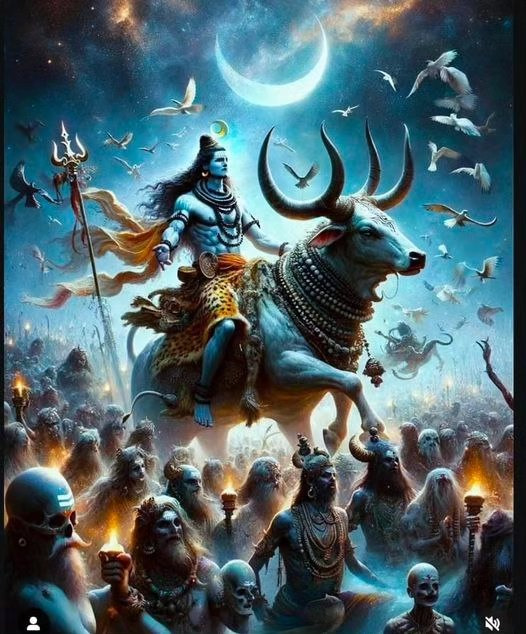
🌹 . శ్రీ శివ మహా పురాణము - 881 / Sri Siva Maha Purana - 881 🌹 ✍️. స్వామి తత్త్వ విదానంద సరస్వతి 📚. ప్రసాద్ భరద్వాజ
🌴. రుద్రసంహితా-యుద్ద ఖండః - అధ్యాయము - 39 🌴
🌻. శంఖచూడుని సైన్యమును వధించుట - 1 🌻
వ్యాసుడిట్లు పలికెను- కాళి యొక్క వచనములను విని ఈశానుడు ఏమనినాడు? ఏమి చేసినాడు? ఓ మహాబుద్ధి శాలీ! నీవా విషయమును చెప్పుము. నాకు చాల కుతూహలముగ నున్నది (1).
సనత్కుమారుడిట్లు పలికెను - కాళి యొక్క మాటలను విని, పరమేశ్వరుడు, గొప్ప లీలలను చేయువాడు, మంగళకరుడు నగు శంభుడు నవ్వి ఆమెను ఓదార్చెను (2). ఆకాశవాణి యొక్క పలుకులను తెలుసుకొని, తత్త్వ జ్ఞాన పండితుడగు శంకరుడు తన గణములతో గూడి స్వయముగా యుద్ధమునకు వెళ్లెను (3). మహేశ్వరుడు గొప్ప వృషభము నెక్కి, వీరభద్రాదులు తోడు రాగా, తనతో సమానమైన భైరవులు, క్షేత్రపాలురు చుట్టువారి యుండగా, వీరరూపమును దాల్చి రణరంగమును చేరెను. అచట ఆ రుద్రుడు మూర్తీభవించిన మృత్యువువలె అధికముగా ప్రకాశించెను (4, 5). ఆ శంఖచూడుడు శివుని గాంచి విమానమునుండి దిగి పరమభక్తితో శిరస్సును నేలపై ఉంచి సాష్టాంగ నమస్కారమును చేసెను (6). ఆతడు శివునకు ప్రణమిల్లిన పిదప యోగశక్తిచే విమానము నధిష్ఠించి వెంటనే ధనుర్బాణములను గ్రహించి యుద్ధమునకు సన్నద్ధుడాయెను (7).
వారిద్దరు అపుడు వర్షించే రెండు మేఘముల వలె భయంకరమగు బాణవర్షమును కురిపిస్తూ వందసంవత్సరములు చేసిరి (8). మహావీరుడగు శంఖచూడుడు భయంకరములగు బాణములను ప్రయోగించగా, శంకరుడు వాటిని తన బాణపరంపరలచే అవలీలగా చీల్చివేసెను (9).
సశేషం…. 🌹 🌹 🌹 🌹 🌹
🌹 SRI SIVA MAHA PURANA - 881 🌹 *✍️ J.L. SHASTRI, 📚. Prasad Bhadwaj *
🌴 Rudra-saṃhitā (5): Yuddha-khaṇḍa - CHAPTER 39 🌴
🌻 The annihilation of the army of Śaṅkhacūḍa - 1 🌻
Vyāsa said:—
O intelligent one, on hearing the narrative of Kālī what did Śiva say? What did he do? Please narrate to me. I am eager to know it.
Sanatkumāra said:—
On hearing the words of Kālī, lord Śiva, the actor of great divine sports, laughed. Śiva consoled her.
On hearing the celestial voice, Śiva, an expert in the knowledge of principles, went himself to the battle along with his Gaṇas.
He was seated on his great bull and surrounded by Vīrabhadra and others, the Bhairavas and the Kṣetrapālas all equal in valour to him.
Assuming a heroic form, lord Śiva entered the battle ground. There Śiva shone well as the embodied form of the annihilator.
On seeing Śiva, Śaṅkhacūḍa got down from the aerial chariot, bowed with great devotion and fell flat on the ground.
After bowing to him he immediately got into his chariot. He speedily prepared for the fight and seized the bow and the arrows.
The fight between Śiva and the Dānava went on for a hundred years and they showered arrows fiercely like clouds pouring down incessantly.
The heroic Śaṅkhacūḍa discharged terrible arrows playfully. Śiva split all of them by means of his arrows.
Continues…. 🌹🌹🌹🌹🌹
🍀🌹🍀🌹🍀🌹🍀🌹🍀🌹 🍀🌹🍀🌹🍀🌹🍀🌹🍀🌹
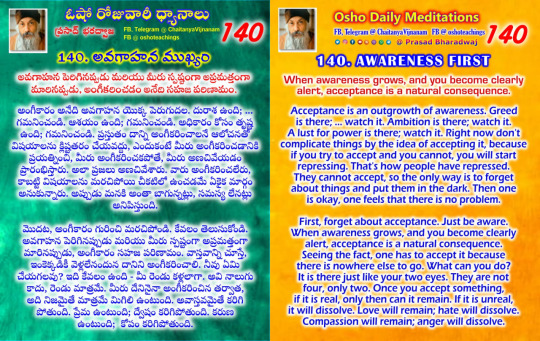
🌹. ఓషో రోజువారీ ధ్యానాలు - 140 / Osho Daily Meditations - 140 🌹 ✍️. ప్రసాద్ భరద్వాజ
🍀 140. అవగాహన ముఖ్యం 🍀
🕉 అవగాహన పెరిగినప్పుడు మరియు మీరు స్పష్టంగా అప్రమత్తంగా మారినప్పుడు, అంగీకరించడం అనేది సహజ పరిణామం. 🕉
అంగీకారం అనేది అవగాహన యొక్క పెరుగుదల. దురాశ ఉంది; … గమనించండి. ఆశయం ఉంది; గమనించండి. అధికారం కోసం తృష్ణ ఉంది; గమనించండి. ప్రస్తుతం దాన్ని అంగీకరించాలనే ఆలోచనతో విషయాలను క్లిష్టతరం చేయవద్దు, ఎందుకంటే మీరు అంగీకరించడానికి ప్రయత్నించి, మీరు అంగీకరించకపోతే, మీరు అణచివేయడం ప్రారంభిస్తారు. అలా ప్రజలు అణచివేశారు. వారు అంగీకరించలేరు, కాబట్టి విషయాలను మరచిపోయి చీకటిలో ఉంచడమే ఏకైక మార్గం అనుకున్నారు. అప్పుడు మనకి అంతా బాగున్నట్లు, సమస్య లేనట్లు అనిపిస్తుంది.
మొదట, అంగీకారం గురించి మరచిపోండి. కేవలం తెలుసుకోండి. అవగాహన పెరిగినప్పుడు మరియు మీరు స్పష్టంగా అప్రమత్తంగా మారినప్పుడు, అంగీకారం సహజ పరిణామం. వాస్తవాన్ని చూస్తే, ఇంకెక్కడికీ వెళ్లలేనందున దానిని అంగీకరించాలి. నీవు ఏమి చేయగలవు? ఇది కేవలం ఉంది - మీ రెండు కళ్లలాగా. అవి నాలుగు కాదు, రెండు మాత్రమే. మీరు దేనినైనా అంగీకరించిన తర్వాత, అది నిజమైతే మాత్రమే మిగిలి ఉంటుంది. అవాస్తవమైతే కరిగిపోతుంది. ��్రేమ ఉంటుంది; ద్వేషం కరిగిపోతుంది. కరుణ ఉంటుంది; కోపం కరిగిపోతుంది.
కొనసాగుతుంది… 🌹 🌹 🌹 🌹 🌹
🌹 Osho Daily Meditations - 140 🌹 📚. Prasad Bharadwaj
🍀 140. AWARENESS FIRST 🍀
🕉 When awareness grows, and you become clearly alert, acceptance is a natural consequence. 🕉
Acceptance is an outgrowth of awareness. Greed is there; … watch it. Ambition is there; watch it. A lust for power is there; watch it. Right now don't complicate things by the idea of accepting it, because if you try to accept and you cannot, you will start repressing. That's how people have repressed. They cannot accept, so the only way is to forget about things and put them in the dark. Then one is okay, one feels that there is no problem.
First, forget about acceptance. Just be aware. When awareness grows, and you become clearly alert, acceptance is a natural consequence. Seeing the fact, one has to accept it because there is nowhere else to go. What can you do? It is there just like your two eyes. They are not four, only two. Once you accept something, if it is real, only then can it remain. If it is unreal, it will dissolve. Love will remain; hate will dissolve. Compassion will remain; anger will dissolve.
Continues… 🌹 🌹 🌹 🌹 🌹
🍀🌹🍀🌹🍀🌹🍀🌹🍀🌹 🍀🌹🍀🌹🍀🌹🍀🌹🍀🌹
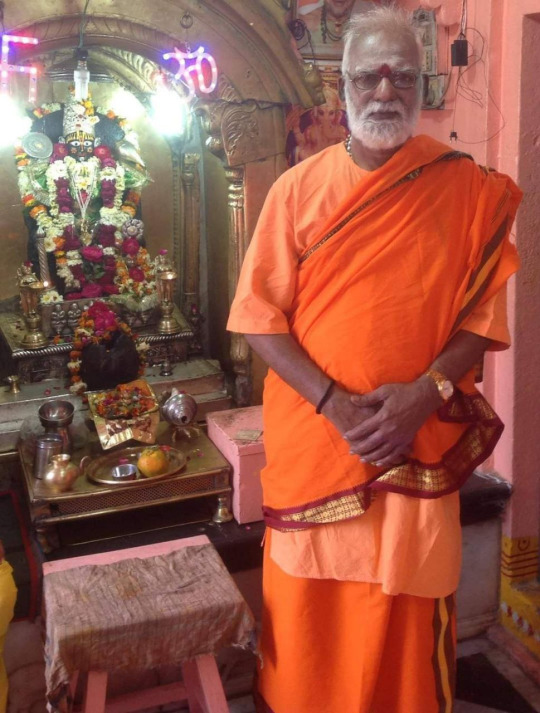
🌹 సిద్దేశ్వరయానం - 52 🌹
💐 శ్రీ సిద్దేశ్వరానంద భారతీ స్వామి విరచిత 💐
🏵 16వ శతాబ్దం 🏵
కొంత కాలం కాళీయోగి కాశీలో ఉన్నాడు. అక్కడ త్రైలింగస్వామి అనే యతి కాళీ సాధన చేసి ఇతనివలె మూడు వందల యేండ్లు జీవించే వరం పొందాడు. అతడూ ఈ కాళీ దేవతామూర్తిని అర్చించాడు. అక్కడి నుండి యోగి కొన్నాళ్ళు దక్షిణాపధంలో తిరిగాడు. చిత్రానదీ తీరంలోని కుర్తాళం అతనిని ఆకర్షించింది. ఆ పవిత్రస్థలంలో కొన్ని నెలలు ధ్యానం చేసుకుంటూ అక్కడి ఆర్తుల కష్టాలు తీరుస్తూ గడిపాడు. తిరిగి ఉత్తర భారతానికి బయలుదేరగా దోవలో ఆంధ్ర ప్రాంతంలో శ్రీనాధుడనే కవివర్యునితో పరిచయం కలిగింది. చింతామణి మంత్రసిద్ధుడై రాజ పూజితుడైన ఆ విద్వాంసుని కవిత్వ పాండిత్య ప్రాభవానికి అతడు ముగ్ధుడైనాడు. ఆ కవి-అతిథిగా తన భవనంలో కొంతకాలమైనా ఉండవలసినదిగా ప్రార్థించాడు. ఆతని ఆత్మీయ భావానికి సంతోషించి కొన్నాళ్ళున్నాడు. విపరీతంగా స్త్రీలోలుడు అయిన ఆ కవి చిత్తవృత్తి చాలా చిత్రమనిపించింది. ఆనన్యమైన అతని శివభక్తి, తనకెంతో నచ్చింది. కాళీయోగి అక్కడినుండి బయలుదేరే రోజు ఆ కవిరాజు తన భవిష్యత్తును గూర్చి చెప్పమని ప్రార్ధించాడు.
*ధ్యాన���లో చూచి ఇలా చెప్పాడు. “మహాకవీ!” మీది చాలా గొప్ప జన్మ. ఆ విషయం నేను ప్రత్యే��ంగా చెప్పనక్కరలేదు. ఒక సిద్ధగురువు నీకు దివ్యమంత్రాన్ని ఉపదేశించాడు. ఆ సమయంలో అతడు నీకు కొన్ని నియమాలు పెట్టాడు. ఆ మహామహుని దయ వల్ల నీకు వాక్సిద్ధి లభించింది. నీ రంగంలో నీ ముందు నిలువగల వారుండరు. దిగ్విజయం చేసి సమ్రాట్టులచే కనకాభిషేకాలు పొందుతావు. ఎంతటి రాజులయినా నీ వశులవుతారు. మహాభోగాలు అనుభవిస్తావు. కానీ నీ స్త్రీలోలత నిన్ను దెబ్బతీస్తుంది. నీ పతనానికి దారి తీస్తుంది. ఇప్పుడే కాదు ఇంకా చాలా సంవత్సరాల తర్వాత. ఇప్పుడు నీ ప్రభజగజ్జేగీయ మానంగా వెలుగుతోంది. ఏనాడు నీ సిద్ధగురువు పెట్టిన నియమాన్ని ఉల్లంఘిస్తావో ఆనాడు నీ శకం ముగుస్తుంది.
మరపు వల్ల, కామం వల్ల, నీవు దోషం చేస్తావని, తదనంతరం నీవు హత్య చేయబడి ప్రేతమై కొన్ని వందల సంవత్సరాలు గాలిలో తిరుగుతుంటావని తోస్తున్నది. నీ పురుషకారం వల్ల, దైవభక్తి వల్ల నీ భవిష్యత్తు నేమైనా మార్చుకోగలవేమో ఆలోచించుకో” శ్రీనాధుడు “యోగిశేఖరా! కాళీదేవి అనుగ్రహపాత్రులైన మీరు ఎన్నో విశేషాలు తెలియజేశారు. మీరు చెప్పిన ప్రయత్నం చేస్తాను. కానీ ఎంత కృతకృత్యుడనవుతానో! ముక్కుకుత్రాడు వేసి గంగిరెద్దును దానిని ఆడించువాడు లాక్కువెళ్ళి ఆడించే విధంగా విధినాతో అడుకుంటున్నది. నాకు మనశ్శాంతి లేదు. చిన్నప్పుడే నా తల్లి దండ్రులు మరణించారు. నా స్వగ్రామం క్రాల పట్టణం ఉప్పెన వచ్చి సముద్రంలో కొట్టుకుపోయింది. నా మేనమామ సనత్కుమారభట్టు నన్ను పెంచి పెద్ద చేశాడు. ఆయన కూ��ురును నాకు పెండ్లి చేయాలని ఆశించాడు. ఆ అమ్మాయి చాలా వికారంగా ఉంటుంది.
నా జీవలక్షణం సౌందర్యోపాసన. ఆ అమ్మాయిని పెండ్లి చేసుకోనని తిరస్కరించాను. కృతఘ్నుడవని నన్ను దూషించాడు. నన్ను ఇంట్లో నుండి వెళ్ళగొట్టాడు. ఆయన పెద్ద అధికారపదవిలో ఉండడం వల్ల నా కెవ్వరూ ఆశ్రయమివ్వలేదు. ఆగమ్మకాకినై ఊళ్ళు పట్టుకు తిరిగాను. ఒక సిద్ధుడైన మహానుభావుడు కరుణించి మంత్రోపదేశం చేశాడు. అది సిద్ధించింది. దాని వల్ల వాగ్దేవి అనుగ్రహించింది. మహా కవియైన మా తాతగారు కమలనా భామాత్యుని వారసత్వంగా కవిత్వం వచ్చింది. సరస్వతీ చింతామణీదేవి ఇచ్చిన శక్తి వల్ల సాహిత్యరంగంలో అప్రతిహత పరాక్రమంతో ప్రకాశిస్తున్నాను. దాని వల్ల సిరిసంపదలు లభించినవి. మీ వంటి మహానుభావులకు ఆతిధ్యమిచ్చి పూజించుకోగల అవకాశం లభించింది. అయితే మీరు నా భవిష్యత్తును గూర్చి చెప్పిన విషయాలు విన్నప్పుడు దిగులు కలుగుతున్నది. నా సాధనశక్తి చాలా పరిమితమైనది. దానివల్ల విధిని మార్చగలనని నాకు నమ్మకం లేదు. నన్ను మీరే రక్షించాలి. బ్రతుకు బాటలో ముండ్ల మీద ఉండవలసి వచ్చింది. ఎన్నో మలుపులు వచ్చినవి. వాటిని మీ ముందు ఏకరువుపెట్టను. ఆ పరిస్థితులలో స్త్రీలోలుడనైనాను. అయితే యే పతివ్రత జోలికి పోలేదు. నా మంత్ర గురువులు మీకు తటస్థించవచ్చు. నేను ఎప్పుడైనా తప్పుచేస్తే నన్ను దయతో క్షమించమని వారికి చెప్పండి. వారిని మళ్ళీ చూచే అవకాశం ఉన్నదో, లేదో వా రెక్కడ ఉన్నారో ? ఏదైనా నన్ను మీరు కాపాడాలి అని ప్రార్ధించాడు. ( సశేషం ) 🌹🌹🌹🌹🌹
🍀🌹🍀🌹🍀🌹🍀🌹🍀🌹 🍀🌹🍀🌹🍀🌹🍀🌹🍀🌹
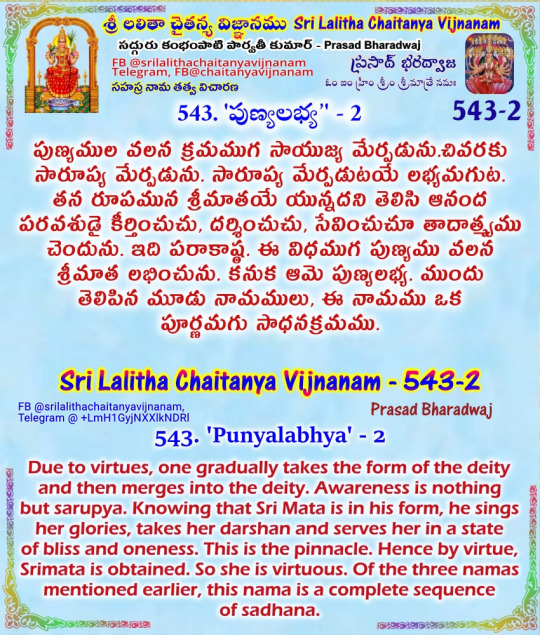
🌹. శ్రీ లలితా చైతన్య విజ్ఞానము - 543 - 2 / Sri Lalitha Chaitanya Vijnanam - 543 - 2 🌹 🌻. లలితా సహస్ర నామముల తత్వ విచారణ 🌻 ✍️. సద్గురు శ్రీ కంభంపాటి పార్వతీ కుమార్ సేకరణ : ప్రసాద్ భరద్వాజ 🍁. మూల మంత్రము : ఓం ఐం హ్రీం శ్రీం శ్రీమాత్రే నమః 🍁
🍀 111. పుణ్యకీర్తిః, పుణ్యలభ్యా, పుణ్యశ్రవణ కీర్తనా । పులోమజార్చితా, బంధమోచనీ, బంధురాలకా ॥ 111 ॥ 🍀
🌻 543. 'పుణ్యలభ్య’' - 2 🌻
పుణ్యముల వలన క్రమముగ సాయుజ్య మేర్పడును.చివరకు సారూప్య మేర్పడును. సారూప్య మేర్పడుటయే లభ్యమగుట. తన రూపమున శ్రీమాతయే యున్నదని తెలిసి ఆనంద పరవశుడై కీర్తించుచు, దర్శించుచు, సేవించుచూ తాదాత్మ్యము చెందును. ఇది పరాకాష్ఠ. ఈ విధముగ పుణ్యము వలన శ్రీమాత లభించును. కనుక ఆమె పుణ్యలభ్య. ముందు తెలిపిన మూడు నామములు, ఈ నామము ఒక పూర్ణమగు సాధనక్రమము.
సశేషం… 🌹 🌹 🌹 🌹 🌹
🌹 Sri Lalitha Chaitanya Vijnanam - 543 - 2 🌹 Contemplation of 1000 Names of Sri Lalitha Devi ✍️ Prasad Bharadwaj
🌻 111. Punyakirtih punyalabhya punyashravana kirtana pulomajarchita bandhamochani bandhuralaka ॥111 ॥ 🌻
🌻 543. 'Punyalabhya' - 2 🌻
Due to virtues, one gradually takes the form of the deity and then merges into the deity. Awareness is nothing but sarupya. Knowing that Sri Mata is in his form, he sings her glories, takes her darshan and serves her in a state of bliss and oneness. This is the pinnacle. Hence by virtue, Srimata is obtained. So she is virtuous. Of the three namas mentioned earlier, this nama is a complete sequence of sadhana.
Continues… 🌹 🌹 🌹 🌹 🌹
0 notes
Text
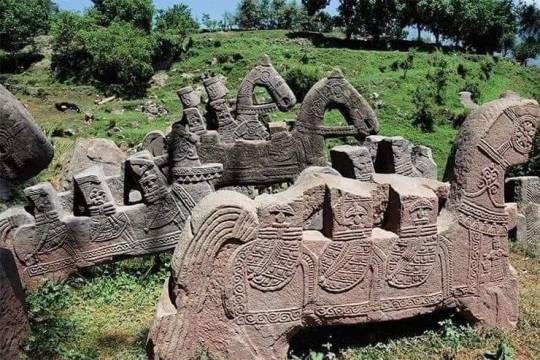
#卍HİNT MİTOLOJİSİ VE KAYNAKLARINDA #卍TÜRKLER
"Ramayana, Mahabharata .Harivamşa"
#卍Türklerden ve #Hunlardan bahseden Hint metinleri daha cok milattan sonraki cağlara aittir.
Bunlar da “Purana” metinleri15, devasa buyuklukteki masal derlemesi olan “Kathasaritsagara”, Keşmir Kralları Tarihi olan “Racatarangini” ve Sanskrit dram olan “Raghuvamsha”’dır.
Unlu Hint Destanları olan ve tahminen M.O.200-M.S. 200 yılları arasında derlenip yazıya gecirilmiş olan Ramayana, Mahabharata (M.O.300-M.S.300) ve Harivamşa da dikkatle incelenmesi gereken metinlerdir.16
Ozellikle de Mahabharata Destanı’nda #卍Hunlardan bahsedilmektedir.17
Bundan başka Manu Kanunları veya Şathapatha Brahmana gibi Hindu metinler ile Buddhist ve Caynist kaynaklar da ayrıntılı bir şekilde incelenmelidir.
Başka bir eski Hint metinleri olup, destanlardan farklı olarak basit bir Sanskrit dili ile yazılmış ceşitli efsaneleri, oğretileri, kral şecerelerini, tarih, coğrafya, mitoloji gibi konuları icine alan Puranaların yazılış tarihleri M.S. 250 ile 1250 yılları arasındadır.
Hint Edebiyatında on sekiz buyuk Purana, on sekiz kucuk Purana vardır.
Bunların her biri farklı tarihlerde yazılmıştır.
Bu on sekiz Purananın isimleri ise şu şekildedir: Vishnu, Narada, Bhagavata, Garuna, Padma, Varaha, Brāhmanda,Brahmavaira, Markaņdeya, Bhavishya, Vāmana, Brahma, Matsya, Kurma, Liņga,Şiva, Skanda, Agni.18 Bu Puranalarda Hindistan coğrafyasından bahsedilirken,Hindistan’da yaşayan halklar ve civarındaki komşular sayılır zaman zaman.
Bu halk isimleri arasında Türklerin bulunduğu da saptanmıştır. Orneğin en eski Puranalardan biri olan Markendaya Purana’da Hindistan’ın kuzeybatısındaki halklar arasında Pallavalar (#Pehleviler), #Gandharalar, Sindhular ve bircok kavimle birlikte Sauviralar da sayılır ki bu eseri İngilizceye cevirip neşreden E.Pargiter bunların arasında
Hunların da bulunduğunun Kurma Purana’da yazdığını iletmektedir. Markandeya Purana da “Tarakshura” adı gecmektedir ki Pargiter bunun da Madhyadeşa denilen orta ulkenin batısında yer alan Türkistan adındaki ulkenin halkı “Türkler” olduğunu söyler.
Ayrıca Unlu Hint destanlarından biri olup, yazılış tarihi M.O. 300 ile M.S.300 arasında ve yazarı olarak da Vyasa gosterilen,19 “Buyuk Bhārata Soyu” anlamına gelen Mahābhārata Destanı’nda gecen “Tarkshyalar” ile bunların aynı olduğunu belirtir.
Yine Markaņdeya Purana’nın LVIII. bolumunde Hunların adı gecer ve Pargiter bunların “Ak Hunlar” olduğunu ve o zaman Sutlej ırmağının kuzeyinde kalan vadinin “Hundes” diye bilindiğini aktarır.
Bu halkın kuzeyde Çinlilerle komşu olduğunu bildirerek Mahābhārata’ ya gonderme yapar.20
Yine eski bir Purana olan Vamana Purana’da eski metinlerde Bharatavarsha diye de bildiğimiz fakat burada Cambudvipa adıyla adlandırılan Hindistan alt kıtasının dokuz bolgeden oluştuğu soylenir.
“Ortada İlavrita Varsha, doğuda Bhadraşva, kuzeydoğuda Hiranya, batıda Ketumala, kuzeybatıda Ramyaka, kuzeyde Kuruvarsha, kuzeydoğuda Kimpurusha Varsha.”
Bunların arasında buyuk mesafelerin olmadığı kutlu ve hoş yerler olduğu,
buralarda hic caba harcanmadan mutlu yaşantılar surdurulduğu belirtilir. Aralarında hicbir catışma cereyan etmeden yaşadıkları ve birbirinden sınırlarla ayrıldıkları vurgulanır. Daha sonraki beyitlerde yine bolgeler sayılırken Türklerin ve Yunanlıların isimleri gecer.
“İndradvipa, Kaseruman, Tamravarna, Gabhastiman, Nagadvipa, Kataha,Simhala, Varuna. Bu bolum denizle cevrelenmiştir, kuzey-guney genişliğinde yer alır ve Kumara adı verilir.
Doğu kıyısında Yavanalar (Yunanlılar) oturur.
Guneyde Andharalar, Kuzeyde de Turushkalar (Türker) barınır.”
Metinde Türklerden soz eden kısım bu kadardır.
Daha sonra Brahmanların, Kshatriyaların ve Vaişya ve Şudraların, karışık kastların dinsel toren, ic cekişme,ticaret ve diğer işlerle nasıl bir arada yaşadıklarından soz edilir.
Sonra bircok dağ ismi sayılır. Bunların arasında Mleccha ve Ari olmak uzere karışık halkların gruplar halinde yaşadıkları soylenir. Sonra nehirler anlatılır ve bunların kutsal oldukları,insanları gunahlardan arındırdıkları belirtiliyor. Bu sulak bolgeler arasında yaşayan halklar (canapadalar) sayılırken yine Yunanlılar (Yavanah), Barbarlar (Barbarah) ve Çinlilerin (Cinah) isimleri de gecer.21
Vishnu Purana’da22 da Hunlar’dan şoyle bahsedilmektedir:
“Hindistan’ın doğusunda yabancı kavimler, batısında Yunanlılar vardır. Orta ulkede ise Brahmanlar, Kshatriyalar, Vaişyalar ve Şudralar (Bunlar kast sisteminin sınıflarıdır) her tarafa dağılmışlardır. İndus’a komşu olan Sauviralar, Sindliler (Saindhavah), Hunlar (Hunah), Şalvalar (Şalvah), Sakalılar, Madralılar, Rama halkı (Ramayana Destanı’nın başkarakterlerinden olan Rama’nın halkı), Ambastha halkı ve Persler (Parasika) idi.”
Keşmirli yazar Somadeva’nın tahminen 1070’te derlediği Kathasaritsagara (Masal Irmaklarının Okyanusu) adlı eserde bildiğimiz kadarıyla, Türklerden iki yerde soz edilir.
Bunlardan biri “Devadasa Oykusu”icinde gecer ki burada şunları goruyoruz;23
“Kral Candramahasena, Padmavati ile karşılaştığında kendi kızını gormuş gibi sevindi. Ancak birkac gun dinlendikten sonra Vatsa’nın mutlu kralı, kayınbabasının ordularıyla desteklenmiş halde, batı bolgesine doğru ilerlemeye başladı.
Lata bolgesinin (Gucerat) kadınlarının gozyaşlarına bulanmış kıvrık kılıcı,onun yiğitlik ateşinin dumanına benziyordu.
Ağacları onun filleri tarafından ezilmiş Mandara Dağı, okyanusu calkalamak icin yine kendisini kullanacaklar diye korkusundan tir tir titriyordu. Onun guneşten bile parlak olduğu kuşku goturmezdi; o,batıda bile yukselen bir ihtişama sahipti.
Sonra o, Kailasa Dağının gulumsemesiyle guzelleştirdiği tanrı Kubera’nın yerinden ayrıldı ve Alaka’ya gitti. Orada Sindh
kralına boyun eğdirdi, ordusunun başında, Rama’nın Rakshasaları24 yok etmesi gibi Mlecchaları ortadan kaldırdı. Türklerin suvari birlikleri, dalgaların kıyı boyunca uzanan ağaclara carpıp durması gibi, onun fillerine carpıp kırılıyordu. Duşmanlarının bile takdir ettiği kahraman, tıpkı tanrı Vishnu’nun Rahu.’ya yaptığı gibi, Perslerin kotu kralının başını ucurdu. Hunları da savdıktan sonra onun unu dort yone yayıldı ve Himalayalardan ikinci bir Ganj gibi dokuldu...”
Kathasaritsagara’dan vereceğimiz ikinci ornek “Nişcayadatta Oykusu”icindedir.25
“Ucceyini kentinde Nişcayadatta adında bir tuccar oğlu vardır. Bu genc, bir gun Anuragapara adında bir peri kızına (Vidyadhari) aşık olur. Onunla evlenebilmesi icin gokyuzundeki ulkesine gelmesi gerekmektedir. Kız bu şartı soyleyip gokyuzune ucar gider. Oğlan ertesi gun yollara duşer ve kendisi gibi tuccar cocuğu olan uc gencle karşılaşır.
Birlikte dere tepe yol alırlar ve kuzeye, yabancı kavimlerin oturduğu yerlere varırlar. Yolda bir kısım Tacik onları yakalayıp başka bir Tacik’e satar. O da onları Muravara adında bir Türk’e(Turushka) hediye olarak verir.
Onları goturen hizmetkarlar Muravara’nın olduğunu oğrenince onları onun oğluna teslim ederler. Muravara’nın oğlu onları babasının dostuna ertesi sabah geri gondermek uzere zincire vurdurtur. Gencler tanrıca Durga’ya yalvarırlar ve tanrıcanın yardımıyla zincirlerinden kurtulup kacarlar. Diğer gencler bu yabancı halklarla dolu kuzey bolgesinde daha fazla kalmak istemeyip guneye, Dekkan’a doğru giderler.
Nişcayadatta ise, aşık olduğu peri kızı icin kuzeydeki yolculuğuna devam eder.Oldukca uzun olan bu oyku, kadınların sadakatsizliğini belirten bir sonla noktalanır.”
Racatarangini’ye (Krallar Nehri) bakacak olursak, burada Ak Hunlar ve Türklerden daha sık soz edildiğini goruruz. Keşmirli tarihci Kalhana bu eseri 10-11.yuzyıllarda yazmış olup 120 beyitten oluşmaktadır.
Burada 10. ve 11. yuzyıllar arasında yaşamış kral ve krallıklar anlatılmaktadır.26 Türklerin genel anlamda Hindistan iclerine girerken Keşmir’e uğramış olmaları, bu yakın coğrafyayı iyi bilen Hintli tarih yazıcısını bizim açımızdan guvenilir kılmaktadır.27
Racatarangini’de AkHunlar ile ilgili olarak, Mihirakula’dan onun Buddhistlere yaptığı baskılardan,Shiva’ya taptığından bahsedilir. Ayrıca burada Ak Hun devletinin Mihirakula’nın olumu ile sona ermediği, daha sonra yonetime Toraman’nın bir zamanlar kacıp saklanan kucuk oğlu Pravarasena’nın tahta gectiğinden bahsedilir.28
Racatarangini’de “Türklerin silahlarını sırtlarında taşıdıkları ve saclarını yarı traş ettikleri” yazar.
Samgaramaraca’yı (Keşmir Vadisinde 1003-1028 yıllarında var olan bir kral) anlatırken bir yerde “Türklerin savaşını tanımadıkca, tutkunuza hakim olup bu tepenin ucurumuna kendinizi koymalısınız” şeklinde bir ifade gecer.
Bu, buyuk ihtimal Gazneli Mahmud’un Hint seferleri ile ilgili olsa gerektir. Sonraki cumlede Hammira ismi gecer ki bu da Mahmud olmalıdır. Yukarıdaki oğudu veren de Hint racası Trilocanapala’dır.
Sonra “sabahleyin, savaş oyunlarında usta olan Türk ordusunun komutanı, tum savaşcı kimliği ile şiddetli bicimde cıkageldi” diye yazar.
Türklerle yapılan savaşlardan soz edilmeye devam edilir.
Racatarangini’de en cok dikkatimizi ceken kısım, buyuk kral Kanishka’nın,kuşkuya yer vermeyecek bicimde, Türk olarak tanıtıldığı yerdir.
Burada şoyle yazar:
“Bu ulkede Hushka, Cushka ve Kanishka adında uc kral kendi isimlerini taşıyan uc şehir kurdular (I,168)… her ne kadar Türk soyundan geliyorlarsa da, dindar işler yapan bu krallar Şushkaletra, Matha ve Caityalar vb. yapılar inşa ettiler.”
Hikmet Bayur, pek cok yerdeki saptamaları ile aynı noktayı eserinde29 irdeleyerek Kanishka’nın Türk olduğundan şuphe duyulamayacağını soyler. El-Biruni Kanishka’dan “Kanık” diye soz eder.30
Burada “Hinduların Kabil’de Türk kralları bulunduğu ve bunların Tibet’ten geldikleri, bunların icinde birincisinin de Barhatekin” olduğu yazılıdır.
Bayur, Turushka’nın Türk olması gibi Kanishka’nın da Kanık olması gerektiğini soyler.31
Nitekim “kanık” sozcuğu bugunku Türkçe’de32 de “elindekinden hoşnut olan, azla yetinen, tok gozlu, kanaatkar” anlamlarına gelir. Kim bilir belki de bu isim Buddhizmi benimsedikten sonra kendisine verilen bir lakaptır.
Gerci Kanık’ın İran’daki Mithra inancına (İran’da guneşe tapınılan inanc sistemi) eğilimi olduğunu soyleyenler varsa da onun Aşoka ve Ekber gibi farklı inancları bir arada tutmaya calışan bir kimse olduğunu duşunmek daha mantıklıdır. 33
Kanishka’nın geldiği kavimin Kuşanlar olduğu, bunların da (Cin kaynaklarındaki adı ile) Yueh-chilerin bir boyu olduğu ve bunların Türklüklerinden hemen hemen hic şuphe edilmediği duşunulurse, yukarıdaki duşuncelerin doğru olduğu ve Benares’e kadar uzanan devletin yoneticisi olan Kanishka’nın ( Kanık’ın) bir Türk olduğu da tarih sayfalarına gececektir.34
Kuşanların giysileri tipik Orta Asya tarzının bir yansıması idi35.
Giysi ile ilgili bir ornek, Michael Edwardes’in “AHistory of İndia” adlı eserinde36 bulunmaktadır.
Milattan sonraki ilk yuzyılda Kuşan devletini kuran kral Kadfises’in paralar uzerindeki adı “Kucula Kadfises”’tir37.
W.Ruben, “kucula” sozcuğunun “guzel” sozcuğune benzediğini bildirmektedir.
Ruben’in hem bu konuda hem de Kuşanlar hakkında soyledikleri şoyledir:
“Hindistan’ın kuzeybatısında Türkistan’dan gelen kuvvetli komutanların idaresi altındaki Kuşanların istilası ile bu devrin yeni bir safhası başlamakta ve milattan yetmiş sekiz sene sonra Vima Kadfises Hindistan’da egemenliği eline almış bulunmaktadır. Bazılarına gore bu donem Kanişka zamanına uymaktadır.
Kanişka devleti daha cok Orta Asya’da idi. Pencab bu devletin sadece bir guney eyaleti idi ve merkezi de Peşaver’de bulunuyordu.
Zaman zaman yapılan akınlarla devletin sınırlarının Patna’ya kadar uzanmış olması mumkundur ve şuphesiz Benares de bu sınırlar icerisinde bulunmakta idi. Kanişka ve hanedanının pek o kadar Hintlileşmedikleri anlaşılmaktadır.
Bu hukumdarlara ait heykeller kendilerini Orta Asya suvarilerine ait elbiselerle gostermektedirler. Bu kavimler kultur bakımından Türklere cok benzemektedir. Sikkeler uzerindeki yazıları vesaire ile taşıdıkları unvanlar ve coğu isimler eski Pehlevi dilindedir. Türkçe bir isim olan Kucula bu arada soylenmelidir. Avrupalı araştırmacılar bunları İskit, yani Hint-Avrupa kokenli olarak kabul etmiş bulunmakta ise de, bu etnologlar tarafından henuz uzerinde duşunulmesi gereken bir sorun olarak gorulmektedir. Fakat ne olursa olsun bu Kuşan egemenliğinin, Hint kulturu ve onun Orta Asya’ya yayılması bakımından onemi cok buyuktur.”38
Ak Hun/ Eftalitlerin gectiği bir başka Hint kaynağı unlu şair Kalidāsa’nın yazdığı Sanskrit bir eser olan “Raghuvamsha”’dır.
Bu eserin yazılış tarihi tam olarak bilinmemekle birlikte N.Mukhopadyaya tarafından 1880 yılında İngilizceye cevrilmiş olup bu eserin 4.bolumunun 68. beyitinde Hunların Amu Derya vadisinde yaşadığından ve kahraman Raghu’nun zaferini duyan Hunların eşlerinin yanaklarının kızardığından bahseder.39
Bana tarafından Kral Harsha’ya yazılan “Harshacarita”’da da Meşhur kral Harsha’nın babasının 7. yuzyılın başlarında Hunlara yenildiği anlatılır.40
Bu eserin Sanskrit dilindeki yazılış tarihi bilinmemekle birlikte 1897 yılında E.B.Cowell ve F.W.Thomas tarafından İngilizceye cevrilmiştir.
Bizim yaptığımız araştırma sonucunda Ak Hun/ Eftalitlerden bahseden son kaynak da Jaisalmer’in yazdığı bir Caynist kitap olan Kuvalayamala’dır.
Bu kitabın da yine diğer Sanskrit metinlerde olduğu gibi yazılış tarihi bilinmemekle birlikte C.Chojnacki ve U.Sauri tarafından 2008 yılında Fransızcaya tercumesi soz konusudur.
Burada da Hunlara ait yazıtlar, Hun yoneticileri, onların savaşları,
zaferleri ve yenilgileri anlatılıyor.41
AK HUNLAR TARİHİ UZERİNE TÜRKİYE VE DUNYADA YAPILAN
CALIŞMALARIN DEĞERLENDİRİLMESİ
Doç.Dr.Müslüme Melis CELİKTAŞ –KTÜ Tarih Bölümü /Trabzon
DİPÇE :
15 Aradi, a.g.m., s.6; Kaya, a.g.m., s.4.
16 Kaya, a.g.m., s.4.
17 Konukcu, a.g.t., 43; Bu metinlerde Vana Parva LI,1991; Bhishma Parva IX,373 gibi
aynı zamanda Sabha Parva XXXI,1194 ve I,1844’te Harahuna yani Sarı Hunlardan
bahsedilmektedir.
18 Kaya, a.g.e., s.88.
19 Kaya, a.g.e., s.87.
20Kaya, a.g.m., s.3.
21Kaya, a.g.m., s. 6-7.
22Aradi, a.g.m., s.6.
23Kaya, a.g.m., s.5.
24 Hint Destanlarında gecen “Rakshasa” “ifrit” demektir.
25Kaya, a.g.m., s.8.
26 M.A.Stein, Kalhana’s Rajatarangini, Vol. 1, Book 1-4, Edinburgh 1900, s.42.
27Kaya, a.g.m., s,9.
28Aradi, a.g.m., s.17.
29 Y.H.Bayur, Hindistan Tarihi, C.1, Ankara,1987, s.42; Kaya, a.g.m., s. 9.
30 E.C.Sachau, Alberuni’s India, Vol 2, New Delhi 2004, s. 11; Kaya, a.g.m., s. 9.
31 Bayur, a.g.e., s.71; Kaya, a.g.m., s. 9.
32 Turkce Sozluk, Ankara 2010, s. 423; Kaya, a.g.m., s. 9.
33 H.Kulke, D.Rothermund, Hindistan Tarihi, Ankara 2001, s. 123-124; Kaya,
a.g.m., s. 9.
34Kaya, a.g.m.,s.10.
35 Kulke, Rothermund, a.g.e., s.123; Kaya, a.g.m., s. 10.
36 M.Edwardes, A History of India, Thames and Hudson, London 1961, s.75-76.
37 Bayur, a.g.e., s.74.
38 Kaya, a..g.m., s.10.
39 Aradi, a.g.m., s.6.
40 E.B.Cowell, F.H.Thomas, The Harsha Carita of Bana, chapter 4, London 1897
s.101.
41Aradi, a.g.m., s.7.
KAYNAKLAR :
Akbulut, D.A. “İlkcağda Soğdia ve Bakteria ile Hindistan İlişkileri”, Tarihte Turk-
Hint İlişkileri Sempozyumu Bildirileri 2002, Ankara 2006.
Akbulut, D.A. “Maveraunnehir ve Horasan’da Turkler” Turkler Ansiklopedisi,
Ankara 2006.
Aksan D. Turk Dilbilgisi, İstanbul 1962.
Alram, M., “Huns and Western Turks in Central Asia and Northwest India”,
Glasgow 2009.
Altheim, F., Geschichte der Hunnen I, Berlin 1959.
Aradi, E., “The History of White Huns”, Mikes International, c.VIII, Den Haag
2001.
Aradi, E., “The Yue-chis, Kushans,Hephtalites”, Mikes İnternational, C.2,
Den Haag 2010.
Bayur, Y.H., Hindistan Tarihi, C.1, Ankara 1987.
Beal, S., Si-yu-ki, Buddhist Records or The Western World, C.I, Londra
1906.
Blockley R.C., The History of Menander The Guardsman, Ottawa 1985.
Biro, M., “Hunların Kafkasya’daki Varlığı”, Cev.S.Eğilmez, Ataturk
Universitesi Turkiyat Araştırmaları Enstitusu Dergisi,
Erzurum 2003.
Chavannes, E., Documents sur Les Tou-kiue (Turks) Occiedentaux, A Librairie
d’Amerique et d’Orient Adrien Maisonneuve, Quebec 2006.
Compareti, M., “Traces of Buddhist Art in Sogdiana”, Sino-Platınic Papers, USA
2008.
Cowell, E.B., F.H.Thomas, The Harsha Carita of Bana”, Londra 1897.
Csurgai, B., The Hsingnu-Hunnic Hungarian Language and History-Further
Analysis, Hungary 2010.
Czegledy, K., “Geschishte Der Hephthaliten”, Acta Antiqua, Tomus, 28, Budapeşt
1980.
Christian, D., A History of Russia, Central Asia and Mongolia, vol 1, Australia
1998.
Dani, A.H., “Eastern Kushans and Kidarites in Gandhara and Kashmir”,
History of Civilization of Central Asia, London 1996.
Deguignes, J., Hunların, Turklerin, Moğolların ve daha sair Tatarların Tarih-i
Umumisi, cvr. Hiseyin Cahid, C.II, İstanbul 1923.
De Saint Martin, V., Les Huns Balancs ou Ephthalites, Paris 1849
Dewing, H.B., Procopius, History of Wars , Book 1,Trans.H.B.Dewing, London
2005 .
Durak, N., “Hindistan’da Saka, Kuşan ve Ak Hunlar”, Tarihte Turk-Hint
İlişkileri Sempozyumu Bildirileri 2007, Ankara 2008.
Eberhard, W., Cin’in Şimal Komşuları, Cev. N. Uluğtuğ, Ankara 1996.
Edwardes, M., A History of India, London 1961.
El-Belazuri, Futuhu’l Buldan, Cev. M.Fayda, Ankara 1987,
Enoki, K., “The Origin of the White Huns or Hephthalites”, East and West 3,
Bellinghom/ Washington 1955.
Enoki, K., “On The Nationality of the Ephthalites”, Memories of the Research
Department of the Toyo Bunko, XVIII, 1959.
Enoki, K., “The Liang chih-kung-t’u”, Memories of the Research Department
of the Toyo Bunko, sayı 42, 1984.
Fleet, F., “The coins and history of Toramana”, The Indian Antiquary
XVIII, India 1889.
Fergusson, J., “On Indian Chronology”, Journal of the Royal Asiatic Society of
Great Britain and Ireland C.4, London 1869.
Frye, R.N., “Selcuklulardan Evvel Orta Şarkta Turkler”, Belleten, c.10, sayı, 37-
40, Ankara 1946.
Gomec, S., “Boyla ve Baga Unvanı”, ODU Sosyal Bilimler Enstitusu, Sosyal
Bilimler Araştırma Dergisi, C.1, S. 1, 2010.
Gomec, S., Kok Turk Tarihi, 3.Baskı, Ankara 2009.
Gomec, S., Turk Kulturunun Ana Hatları, Ankara 2006.
Gomec, S., Turk Destanlarına Giriş, Ankara 2009.
Grousset, R., The Empire of the Steppes, Cev. N.Walford, New Brunswick
1970
Gunaltay, Ş., Mufassal Turk Tarihi, C.3, İstanbul 1339.
Harmatta, J., “Kidara and Kidarite Huns in Keşmir”, Acta Antiqua, XXVIIXXVIII,
1-4, Hungariae 1979-1980.
Harmatta, J., “Late Bacterian Inscriptions”, Acta Antiqua Scientariun Hungarica
17, Budapeşt 1969.
Harmatta, J., “Annexation of The Hephthalite Vassal Kingdoms By The Western
Turks”, History of Humanity, C. VI, Paris1996.
Indicopleustes, C., The Christian Topography of Cosmos, Cev. J.W.McCrindle,
London 2010.
İtil, A., Sanskrit Klavuzu, Ankara 1963.
Kaya, K., “Eski Hint Metinlerinde Turk”, Argos Gemicileri, sayı 10, Ankara
2003.
Kaya, K., Hint Mitoloji Sozluğu, 2. Baskı, , Ankara 2003.
Kaya, K. Okyanusun Kıyısında, Ankara 2003,
Kafesoğlu, İ., Turk Milli Kulturu, 4.baskı, İstanbul 1986.
Konukcu, E., “Ak Hunlar”, Turkler Ansiklopedisi, C.1, Ankara 2006.
Konukcu, E., “Kuşan ve Akhunlar tarihi”, Doktora Tezi, Ankara 1973.
Konukcu, E., “Halaclar” Turkler Ansiklopedisi, Ankara 2006.
Kulke, H.,D.Rothermund, Hindistan Tarihi, Ankara 2001.
Kumar, R., History of The Chamar Dynasty, India 2008.
Kushava, R.S., A Glimpse of Bharatiya History, Delhi 2003.
Le Strange, G., The Lands of the Eastern Caliphate, Newyork 2010.
Ligeti, L., “Atilla Hunlarının Menşei”, Atilla ve Hunları, Neş. G.Nemeth, Cev.
Ş. Baştav, Ankara 1982.
Litvinsky, B.A., “The Hephthalite Empire”, History of Civizilation of Central
Asia, vol. 3, Paris 1996.
Litvinsky, B.A. / Z.Safi, “The Later Hephthalites in Central Asia”, History of
Civilization of Central Asia, vol 3, Paris 1996.
Macartney, L.A., “ On The Grek Sorces Fort the History of Turks in the Sixth
Century”, Bulletin of the school of Oriental Africa Studies, 11/2,
London 1944.
Maenchen-Helfen, O., The World of Huns, London 1973.
Mangaltepe, İ., Bizans Kaynaklarında Turkler, İstanbul 2009.
Marshak, B., “Sughd and Adjancent Regions”, History of Civilization of Central
Asia, vol. 3, Paris 1996.
Marshall, J., A Guide to Taxila, Calcutta 1918.
Massom, V.M., “Archaelogical Cultures of Southern Siberia and Mongolia” History
of Humanity, c.IV, Paris 1996.
Mc Govern, W.M., The Early Empires of Central Asia, North Carolina 1939.
Melzer, G., “A copper scroll inscription from the time of the Alchon Huns”,
J.Braarvig(ed). Manuscripts in Schoyen Collection III, Oslo
2006.
Mingana, A., The Early Spread of Christianity in Central Asia and The Far
East, C. 9, Manchester 1921.
Minorsky, V., “Khurāsān at the Time of the Arab Conquest”, Iran and Islam in
Memory of the Late, Edinburg 1971.
Modi, J.J., “About the Huns who conquered India”, Journal of the Bombay
Branch of the Royal Asiatic Society , Bombay 1926.
117
Moravcsik, G., Byzantinoturcica II, cev.E.J.Brill, Leiden 1983.
Morgan, D., The Mongols, Singapur 2007.
Obrusanzky, B., “Late Huns in Caucasus”, Mikes International,Journal of
Eurasian Studies, Vol1, Issue 2, Den Haag 2009.
Ogel, B., “İlk Toles Boyları”, Belleten, C.10, Ankara 1948.
Ruben, W., “Doğuda ve Batıda Ortacağ Felsefesi”, Dil ve Tarih, Coğrafya
Fakultesi Dergisi., cilt 2, sayı 1, Ankara 1943.
Roux, J.P., Turklerin Tarihi, Ankara 2004.
Stein, M.A., Kalhana’s Rajatarangini, Vol. 1, Book 1-4, Edinburgh 1900.
Stark, S., Transoxanien nach dem Tang Huiyao des Wang Pu, Nordestedt
2009.
Samolin, W., “Hsiung-nu, Hun, Turk”,Central Asiatic Journal, New Jersey 1957.
Sundermann, W., Origin and Rise of the Chionities/Xyon/Huns, History of Humanity
Scientific and Culture Development, vol. 3, Paris 1996.
Skrine, F.H. - G.D. Ross, The Heart Of Asia, London 1899.
Smith, V., The Oxford History of India, London 1921.
Sinor, D., “The Establishment and Dissolution of the Turk Empire,” The
Cambridge History of Early Inner Asia, London 1994.
Sachau, E.C., Alberuni’s India, Vol 2, New Delhi 2004.
Stark, S., Transoxantan nach dem Tang Huiyao des Wang Pu, Norderstedt
2009.
Şeşe R., İslam Coğrafyacılarına Gore Turkler Ve Turk Ulkeleri, Ankara 2001.
Tezcan, M., “Kuşanlar, Ak Hunlar ve Eftalitler”, Tarihte Turk-Hint İlişkileri
Sempozyumu Bildirileri 2002, dizi XXVI, sayı 12, Ankara 2006.
Tezcan, M., “The Ethonomy Apar in the Turkish Inscriptions of the VIII. Century
and Armenian Manuscripts” Webfestschrift Marshak Ērān ud
Anērān Studies, Venice 2003.
Thapar, R., A History of India, C.1, London 1974.
Thomas, F.W., “A.Tohari (?) A.D. 400”, JSTOR, 1944.
Togan, A.Z.V., “Eftalit Devletini Teşkil Eden Kabilelere Dair”, Ataturk
Universitesi Fen Edebiyat Fakultesi Araştırma Dergisi, Ozel
sayı, Fasukul 1, S.13, Erzurum 1985.
Togan, A.Z.V., Tarihte Usul, İstanbul 1950.
Turkce Sozluk, Ankara 2010.
Watter, T., Yuan Chwang’s Travel in India, C. XIV, Journal of the Royal
Asiatic Society of London 1904
Wincent, A.S., “White Hun Coins From The Panjab”, Journal of the Royal Asiatic
Society of London 1907.
https://dergipark.org.tr/en/download/article-file/1471950
Şenol Soydan
0 notes
Text
Do you think Brahma is a position or someone equal to Lord Shiva and Lord Vishnu?
Both Brahma and Shiva are positions which can be achieved by a jeevatman.
यथर्तुष्वृतुलिङ्गानि नानारूपाणि पर्यये । दृष्यन्ते तानि तान्येव तथा ब्रह्महरादिपु ।। (भारत, शान्तिपर्व, २३२.४०) . Transliteration: yathartuṣvṛtuliṅgāni nānārūpāṇi paryaye dṛṣyante tāni tānyeva tathā brahmaharādipu (Bhārata, Śāntiparva, 232.40) . yathartuShvR^tuli•ngAni nAnArUpANi paryaye dR^Shyante tAni tAnyeva tathA brahmaharAdipu (bhArata, shAntiparva, 232.40) . Translation: As the same phenomena reappear with the reappearance of the seasons, even so, at each new creation, the same attributes appear in each new Brahma and Hara.
अ॒हमे॒व स्व॒यमि॒दं.. मानु॑षेभिः । य॑ का॒मये॒ तं त॑मु॒ग्रं कृ॑णोमि॒ तं ब्र॒ह्माणं.. सु॑मे॒धाम् ॥ ५॥ (ऋग्वेद, १०.१२५.५; अथवा वाक्सूक्तम्/देवीसूक्तम्/अम्भृणीसूक्तम्, मन्त्र - ५)
.
Transliteration:
ahameva svayamidaṁ.. mānuṣebhiḥ… yaṁ kāmaye taṁ tamugraṁ kṛṇomi taṁ brahmāṇaṁ.. sumedhāṁ {5} (Ṛgveda, 10.125.5; or Vāksūktaṁ/Devīsūktaṁ/Ambhṛṇisūkta, Mantra - 5)
.
ahameva svayamidaM.. mAnuShebhiH… yaM kAmaye taM tamugraM kRNomi taM brahmANaM.. sumedhAM {5} (R^gveda, 10.125.5; or vAksUktaM/devIsUktaM/ambhR^NisUktaM, mantra - 5)
.
Translation: I (Devī/Lakṣmī) verily of myself declare this which is approved of by both gods and men; whomsoever I choose, I make him Rudra, I make him Brahma, a ṛṣi, or a seer.
सर्वकामप्रदं नृणामायुरारोग्यवर्द्धनम् । देवदेवत्वममरेशत्वं शिवब्रह्मत्वमेव च ।। (हारीतस्मृति, ३.१७८) . Transliteration: sarvakāmapradaṁ nṛṇāmāyurārogyavarddhanam devadevatvamamareśatvaṁ śivabrahmatvameva ca (Hārītasmṛti, 3.178) . sarvakAmapradaM nR^NAmAyurArogyavarddhanam devadevatvamamareshatvaM shivabrahmatvameva cha (hArItasmR^ti, 3.178) . Translation: All desires of the man (who worships Viṣṇu from the prescribed method) are fulfilled and he earns a long life with good health. He is eligible to get the position of the lord of gods and of the immortals, as well as that of Śiva, and of Brahmā. .. rajyamindrapadaṁ vāpi śivatvaṁ brahmatāmapi (Hārītasmṛti, 3.199) (The man who worships Viṣṇu from the prescribed method) earns a majestic kingdom, and without much effort may he receive the positions of Indra, Śiva and Brahmā.
So, by the grace of Sri Lakshminarayana, the highest positions like Brahma, Shiva and Indra can be achieved by the jivatma, as testified by the quoted scriptures!
#bhagavadgita#bhagawadgita#bhagavatam#bhagavad gita#bhagwad gita#bhagavadgītā#bhagvadgita#bhagwan shiv#bhagwan#bhagwadgeeta#bhagavadgeeta#lordvishnu#lordram#lordkrishna#lordshiva#lord krishna#vedic astro observations#vedic jyotish online#vedas#vedic astrology#krishna#hare krishna#harekrishna#astrology#astrology numerology vedicastrology#brahman
0 notes
Text
Verse 10.22 - Vibhuti Yoga
वेदानां सामवेदोऽस्मि देवानामस्मि वासव: |
इन्द्रियाणां मनश्चास्मि भूतानामस्मि चेतना || 22||
vedānāṁ sāma-vedo ’smi devānām asmi vāsavaḥ
indriyāṇāṁ manaśh chāsmi bhūtānām asmi chetanā
Amongst the Vedas, I am the Sama Veda; amongst the celestial gods, I am Indra. Amongst the senses, I am the Mind; amongst the living beings, I am Consciousness.
This verse is part of the Vibhuti Yoga, where Shri Krishna reveals his divine glories and opulence to Arjuna. He enumerates some of his manifestations in various categories of existence, such as scriptures, deities, senses, elements, etc. By doing so, he intends to increase Arjuna's devotion and knowledge of him, and also to illustrate that he is the source and support of everything.
In this verse, he identifies himself with four aspects: the Sama Veda, Indra, the Mind and Consciousness. The Sama Veda is one of the four Vedas, which are the sacred scriptures of Hinduism. The Sama Veda is known for its musical and poetic expression of the divine hymns. It is also associated with the worship of Indra, who is the king of the celestial gods and the lord of thunder and rain. Indra represents the power and sovereignty of God over the natural and cosmic forces. He is also a symbol of courage and heroism in the face of adversity.
The Mind is one of the five senses, along with sight, hearing, smell and taste. The mind is the faculty that perceives, thinks, feels and wills. It is also the instrument that connects the individual self (jivatma) with the supreme self (paramatma). The mind can be either a friend or an enemy, depending on how it is used. If it is controlled and purified by devotion and knowledge, it can lead to liberation; if it is uncontrolled and impure, it can lead to bondage and suffering.
Consciousness is the essence of all living beings. It is the quality that makes them alive, aware and sentient. Consciousness is also the attribute of God that pervades and sustains all creation. It is the common thread that links all beings with God. Consciousness is also called chetana or chit in Sanskrit, which means "to know" or "to be conscious". Consciousness is the Ultimate Reality and bliss that every soul seeks.
Some other Vedic texts that convey similar ideas are:
- In the Chandogya Upanishad (3.12.6), it is said:
सर्वं खल्विदं ब्रह्म तज्जलानिति शान्त उपासीत | अथ खलु क्रतुमयः पुरुषो यथाक्रतुरस्मिँल्लोके पुरुषो भवति तथेतः प्रेत्य भवति स क्रतुं कुर्वीत ||
sarvaṁ khalvidaṁ brahma tajjalāniti śhānta upāsīta
atha khalu kratumayaḥ puruṣho yathākraturasmil loke puruṣho bhavati tathetah pretya bhavati sa kratuṁ kurvīta
All this is Brahman. From it all things originate and in it they dissolve. One should meditate on it calmly. For as one thinks in this world, so one becomes after death. Therefore one should shape one's thoughts well.
- In the Rig Veda (1.164.46), it is said:
इन्द्रं मित्रं वरुणमग्निमाहुरथो दिव्यः स सुपर्णो गरुत्मान | एक�� सद्विप्रा ��हुधा वदन्त्यग्निं यमं मातरिश्वानमाहुः ||
indraṁ mitraṁ varuṇamagnim āhur atho divyaḥ sa suparṇo garutmān
ekaṁ sad viprā bahudhā vadanty agniṁ yamaṁ mātariśvānam āhuḥ
They call him Indra, Mitra, Varuna, Agni; and he is the heavenly nobly-winged Garutman. To what is One, sages give many a title: they call it Agni, Yama, Matarishvan.
- In the Bhagavad Gita (13.3), it is said:
क्षेत्रज्ञं चापि मां विद्धि सर्वक्षेत्रेषु भारत | क्षेत्रक्षेत्रज्ञयोर्ज्ञानं यत्तज्ज्ञानं मतं मम ||
kṣhetrajñaṁ chāpi māṁ viddhi sarva-kṣhetreṣhu bhārata
kṣhetra-kṣhetrajñayor jñānaṁ yat taj jñānaṁ mataṁ mama
O scion of Bharat, you should understand that I am also the knower in all bodies, and to understand this body and its owner is called knowledge.
0 notes
Text
Bharata, Bhārata, Bharatā, Bharat ~ That is India
||Why Bhārata instead of India|| There is a 2200 years old “Hātigumphā Inscription” found in the ‘Udayagiri Hills’, near Bhubaneshwar in Odisha. This is a very special inscription, as it contains the earliest recorded mention of the word “Bhāratavarṣa” (Prakritized as – ‘Bhāratavasa’). Line number 10 of this inscription mentions “Bharatavarsha” (translation published by Jayaswal and Banerji in…
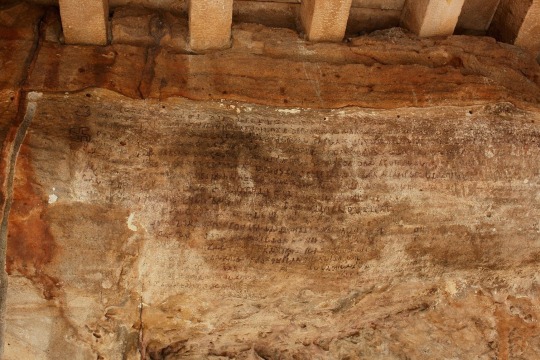
View On WordPress
#agni#ancient#bharat#bharata#bharatavarsha#bharatvarsha#culture#Dasharajna#dasrajana#fire#hinduism#history#india#people#religion#rigveda#vedas#vedic#worship
0 notes